Polarized Light Microscopy Digital Image Gallery
Human Hair
Hair is a unique attribute of mammals, but is particularly significant to humans, despite the fact that its primary functions have become less important to the species in modern times. Indeed, despite its negligible practical use, some people will spend large amounts of money and a great deal of time to have hair replaced, while others endure a similar ordeal to have it removed.

View a second image of Human Hair
Humans, like most mammals, have several different kinds of hair, which typically cover most regions of the body except the soles of the feet and the palms of the hands. Hair is most densely found, however, on the scalp, where it also generally grows to the greatest lengths. Though continually shed and replenished, human hair may grow a half-inch or more per month. The constant cycle of hair loss undergone by humans is often not noticeable because each follicle carries out its processes independently, generally maintaining a constant number of hairs on the head. Shedding is pronounced in certain other mammals, however, because their hair follicles may act in sync, causing pronounced hair loss or molting at certain times of the year.
Each hair on the human scalp is divided into a hair shaft that protrudes from the skin and a hair root, which is embedded in the skin. At the end of the root is a thickened bulb that works in conjunction with the underlying papillae to facilitate the nourishment, development, and growth of the hair. Each hair is further organized into three distinct layers that are tubular in shape. The outermost layer consists of dead, transparent cells known as cuticular scales, while the innermost section, called the medulla, is composed of large cells that are interspersed with air pockets. The cortex that lies between these two layers is composed of several strata of cells that may contain air bubbles and pigments.
